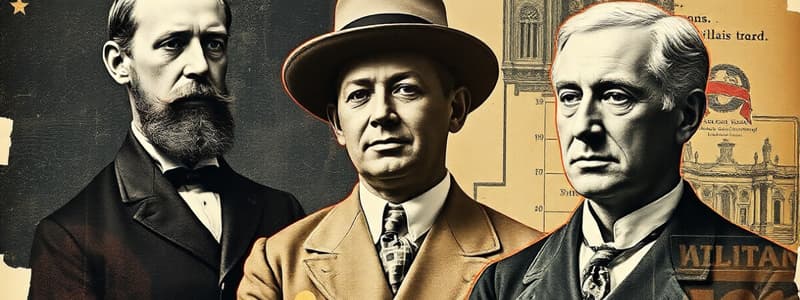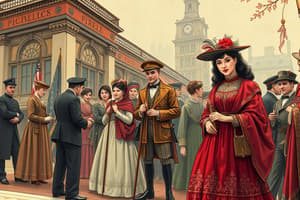Podcast
Questions and Answers
Which act established the Federal Reserve System to regulate the banking system?
Which act established the Federal Reserve System to regulate the banking system?
- Civil Rights Act
- Pure Food and Drug Act
- Meat Inspection Act
- Federal Reserve Act (correct)
What was the primary goal of the Pure Food and Drug Act?
What was the primary goal of the Pure Food and Drug Act?
- To improve working conditions in factories
- To promote direct democracy through citizen initiatives
- To prevent food and drug manufacturers from using harmful additives (correct)
- To ensure racial equality in public facilities
Which issue did the Meat Inspection Act specifically address?
Which issue did the Meat Inspection Act specifically address?
- Promotion of civil rights for minorities
- Economic regulation of monopolies
- Protection against consumer fraud
- Sanitary conditions in meatpacking facilities (correct)
Which of the following themes is most related to efforts aimed at breaking up monopolies?
Which of the following themes is most related to efforts aimed at breaking up monopolies?
What was a significant outcome of the Progressive Era related to consumer rights?
What was a significant outcome of the Progressive Era related to consumer rights?
Which Progressive Era figure is best known for trust-busting and conservation efforts?
Which Progressive Era figure is best known for trust-busting and conservation efforts?
Who was a key advocate for civil rights and co-founded the NAACP?
Who was a key advocate for civil rights and co-founded the NAACP?
Which figure is recognized for highlighting the issue of urban poverty through the establishment of Hull House?
Which figure is recognized for highlighting the issue of urban poverty through the establishment of Hull House?
What significant legislation did Woodrow Wilson's administration introduce to regulate banking?
What significant legislation did Woodrow Wilson's administration introduce to regulate banking?
Which activist is best known for her anti-lynching campaigns?
Which activist is best known for her anti-lynching campaigns?
Who was instrumental in advocating for direct democracy through referendums and initiatives?
Who was instrumental in advocating for direct democracy through referendums and initiatives?
Which author exposed the unsanitary practices of the meatpacking industry, leading to food safety legislation?
Which author exposed the unsanitary practices of the meatpacking industry, leading to food safety legislation?
Which reformer worked specifically on labor laws aimed at protecting women's and children's rights?
Which reformer worked specifically on labor laws aimed at protecting women's and children's rights?
Flashcards
What was trust-busting?
What was trust-busting?
Breaking up large corporations (monopolies or trusts) to encourage competition and prevent wealth concentration.
How did the government regulate businesses during the Progressive Era?
How did the government regulate businesses during the Progressive Era?
Government stepped in to control monopolies and protect consumers by setting rules and regulations.
What was consumer protection during the Progressive Era?
What was consumer protection during the Progressive Era?
Ensuring food safety and fair practices in business. Laws like the Pure Food and Drug Act aimed at these.
What was social reform during the Progressive Era?
What was social reform during the Progressive Era?
Signup and view all the flashcards
What did the Federal Reserve Act do?
What did the Federal Reserve Act do?
Signup and view all the flashcards
Who was Theodore Roosevelt and what were his key policies?
Who was Theodore Roosevelt and what were his key policies?
Signup and view all the flashcards
What were Woodrow Wilson's key accomplishments?
What were Woodrow Wilson's key accomplishments?
Signup and view all the flashcards
How did Jane Addams contribute to the Progressive Era?
How did Jane Addams contribute to the Progressive Era?
Signup and view all the flashcards
What was W.E.B. Du Bois's main goal?
What was W.E.B. Du Bois's main goal?
Signup and view all the flashcards
What was Ida B. Wells known for?
What was Ida B. Wells known for?
Signup and view all the flashcards
How did Robert La Follette impact the Progressive Era?
How did Robert La Follette impact the Progressive Era?
Signup and view all the flashcards
What impact did Upton Sinclair's "The Jungle" have?
What impact did Upton Sinclair's "The Jungle" have?
Signup and view all the flashcards
What was Florence Kelley's main goal?
What was Florence Kelley's main goal?
Signup and view all the flashcards
Study Notes
Key Figures of the Progressive Era
- Theodore Roosevelt (1901-1909): Championed trust-busting, conservation, and consumer protection. Initiated numerous reforms to regulate corporations, leading to anti-monopoly legislation. Known for the "Square Deal" policy, attempting to balance the interests of labor, business, and the public.
- Woodrow Wilson (1913-1921): Focused on economic reform, creating the Federal Reserve System to regulate banking and currency. His administration introduced significant progressive legislation, including the Clayton Antitrust Act. Prioritized moral diplomacy, aiming for peace through international cooperation.
- Jane Addams (1860-1935): Founder of Hull House, a settlement house in Chicago, providing social services to the poor and immigrants. A key figure in the social justice movement, advocating for women's suffrage and other social reforms. Her work highlighted the plight of urban poverty.
- W.E.B. Du Bois (1868-1963): A prominent African American sociologist, historian, and civil rights activist. Focused on achieving full equality for Black Americans through education, civil rights litigation, and activism. Co-founded the NAACP, and advocated for equal opportunities, challenging racial segregation.
- Ida B. Wells (1862-1931): An African American journalist, author, and activist. Known for her powerful anti-lynching campaigns, demonstrating the brutality of violence against African Americans. Her work was crucial in bringing the issue of lynching to national attention.
- Robert La Follette (1855-1925): A Progressive Republican. Wisconsin became a model for progressive reforms with his legislation. An advocate for direct democracy (referendums, initiatives, and recalls) to empower citizens and combat corruption. A prominent figure in the fight for government efficiency and accountability.
- Upton Sinclair (1878-1968): Author who exposed the unsanitary conditions in the meatpacking industry in Chicago through his novel "The Jungle." His book fueled outrage and led to federal food safety legislation. A pivotal figure in investigative journalism, raising public awareness of social issues.
- Florence Kelley (1859-1932): A social reformer and advocate for women's rights and labor rights. Promoted labor laws, particularly for women and children, advocating for shorter working hours and safer working conditions. A key voice for the concerns of working-class families.
Progressive Era Themes
- Trust-busting: Effort to break up large monopolies and trusts to promote competition and prevent the concentration of economic power in the hands of a few. The goal was to increase competition and economic opportunity.
- Regulation of Businesses: Focus shifted towards government oversight to control monopolies and their potential abuses. This led to legislation aimed at curbing excesses and protecting consumers.
- Consumer Protection: Efforts to address issues like food safety and fair business practices. The Pure Food and Drug Act and Meat Inspection Act were important results of these efforts.
- Social Reform: Addressing issues of poverty, inequality, and working conditions, especially for women and children. Settlement houses and social service organizations emerged to provide support and advocacy for disadvantaged groups.
- Civil Rights: The Progressive Era saw important steps taken regarding civil rights, marked by African American activists who fought racial discrimination and injustice. However, racial segregation and unequal treatment persisted, highlighting that while there was movement, the fight for equality was ongoing.
- Direct Democracy: Efforts to empower citizens through initiatives allowing them to directly create and vote on legislation. Changes were proposed to make government more responsive to the needs and demands of its constituents.
Progressive Era Legislation
- Federal Reserve Act (1913): Established the Federal Reserve System, a central banking system, to regulate and stabilize the banking system, promote monetary stability, and establish a more flexible monetary policy.
- Pure Food and Drug Act (1906): Required food and drug manufacturers to list ingredients accurately and prevent the use of harmful additives.
- Meat Inspection Act (1906): Required strict sanitary conditions in meatpacking houses. Established federal inspection of meat to ensure safety and quality standards.
- Clayton Antitrust Act (1914): Strengthened the Sherman Antitrust Act, preventing business practices thought to unfairly limit competition.
Studying That Suits You
Use AI to generate personalized quizzes and flashcards to suit your learning preferences.




